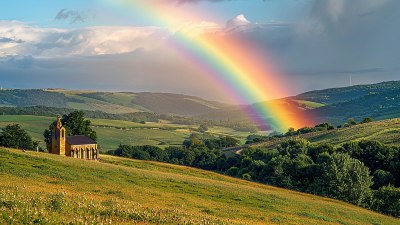The Rain Didn’t Fix It but It Let Us Breathe
Explore how a simple rain shower offered a moment of relief amidst ongoing struggles and stress in life.

Image created with Flux Schnell
Sometimes, life feels overwhelmingly heavy, like a burden that never quite lifts. Days blend into one another, each marked by stress, anxiety, or an unspoken tension that coils in your chest. During those times, even a small change in the environment can offer a surprising amount of comfort. On one particularly difficult afternoon, as the sky darkened and rain began to fall, I felt an unexpected wave of relief wash over me. The rain didn’t fix the problems we were facing, nor did it erase the obstacles ahead, but it let us breathe - just for a moment.
Rain has always held a special place in human experience. It is a phenomenon that brings both challenge and renewal. For farmers, it promises growth and sustenance. For city dwellers, it sometimes brings frustration through inconvenience. Emotionally, rain can symbolize sadness or cleansing, destruction or rebirth. In literature and art, showers and storms often mirror inner turmoil or represent a turning point. So why did this particular rain manage to feel like a balm to our spirits when everything seemed stuck in a pattern of exhaustion?
It’s important to begin by acknowledging the context. The issues we were dealing with did not disappear because the skies opened up and droplets began to fall. There was no miraculous resolution to the financial worries, relationship strains, or personal setbacks. The rain did not give us answers or suddenly fix what was broken. What it did was less tangible, but no less significant: it offered space and time for our minds to pause and our bodies to relax.
In the haze of ongoing difficulties, we often neglect the simplest forms of self-care. Anxiety can make each problem mount relentlessly in our thoughts, permitting little respite. The human brain, although incredibly resilient, demands breaks and moments of stillness to process emotions and avoid burnout. The rain, with its steady rhythmic sound and fresh, cool scent, invited us to slow down and step away, even if briefly, from relentless mental noise.
The moment the first drops hit the earth, there was an almost automatic shift in awareness. Eyes that were fixed on screens or distant worries turned to windows or open spaces, watching as the water blurred the world outside and softened sharp edges. The smell of wet earth—the petrichor—rose and mingled with the damp air, often triggering memories and sensations that feel primal and grounding.
Petrichor is one of those small miracles of nature that is both biological and psychological. When rain hits dry ground, it releases oils from plants and soil microbes, creating that earthy aroma that many find calming and invigorating. For some, the scent is nostalgic, evoking recollections of childhood or simpler times, and that mental connection cannot be underestimated in its soothing impact. It’s as if the earth itself briefly exhales a sigh, inviting us to exhale with it.
Alongside the scent, the sound of the rain playing its natural symphony adds another layer of sensory comfort. Scientific studies have shown that rhythmic, natural sounds such as rain falling or waves crashing often promote relaxation and reduce stress. These sounds act differently from random noise or disruptive sounds. Their consistent pattern and gentle cadence help regulate breathing, slow heart rates, and calm the nervous system. This biological response can create a subtle but powerful emotional shift, even when the source of worries remains.
On that day, as the rain fell, we gathered near the window, sharing quiet moments. There was no need to force conversation or try to solve everything at once. The rain spoke for us in its silence; it suggested that sometimes, what we really need is a breath, an exhale, a pause in the storm of our own making. Without the need for words, it allowed a reconnection - with ourselves and each other.
The phenomenon is not just poetic. Psychologists emphasize the importance of mindful presence, especially when life feels overwhelming. Mindfulness involves paying attention to the present moment with openness and without judgment. Watching rain fall fits beautifully into this practice. It anchors attention away from spiral thinking and into simple observation – feeling the cool air against skin, hearing the droplets falling, noticing reflections on wet surfaces.
Even without formal mindfulness training, many of us instinctively turn to natural occurrences like rain as a form of refuge during challenging periods. The change in weather acts as a physical marker that something different is happening. If only for a little while, the world’s tempo adjusts, shifting from frenetic to measured. This external rhythm meets our internal rhythms, creating a bridge of calm between the chaos inside and the stillness outside.
Moreover, rain subtly alters our environment in ways that encourage quietness and rest. Traffic slows down, outdoor activities pause, and people tend to retreat indoors. With fewer stimuli demanding our attention, there is less temptation to multitask or push ourselves beyond limits. The inherent invitation to slow down becomes both a social and personal encouragement.
Even beyond the immediate atmosphere, rain reminds us of cycles — nature’s eternal ebb and flow. Just as storms give way to clear skies, difficulties in life are rarely permanent. The rain’s pattern, falling and then ceasing, embodies the possibility of change. This symbol offers hope that current hardships may, in time, also soften and pass.
During moments of high tension, it may be difficult to conceptualize hope or allow ourselves to believe that challenges are temporary. Yet rain provides a natural metaphor we can lean on without intellectualizing too much. It is something we feel physically and experience without effort — a shared reality linking us to the larger environment and the passage of time.
Interestingly, the rain’s effect on our emotional state can influence how we approach problems afterward. A study published in the Journal of Environmental Psychology found that exposure to natural elements, including rain soundscapes, can improve mood and cognitive function. When we are less stressed and more centered, our ability to think creatively and cope effectively increases. Thus, while the rain itself does not fix problems, it can indirectly support problem-solving by clearing mental clutter.
Reflecting on the particular rain shower that day, another crucial aspect emerges: the communal experience. We were not alone; others around us also witnessed the changing weather and perhaps felt the same subtle shift. This shared connection, however silent, reinforced an underlying human truth - that we face difficulties together. Whether through spoken words, gestures, or simply being present with someone else in a vulnerable moment, people find resilience in unity.
The power of nature to bring people together is often underestimated. A rainy afternoon can initiate conversations, create a sense of intimacy, or trigger storytelling. These social bonds are vital for emotional well-being. Loneliness and isolation often magnify stress, but moments that foster togetherness provide a counterweight. Even looking out windows at falling rain, knowing others are experiencing it too, links us as part of a collective existence.
It is worth noting that not all experiences of rain are positive for everyone. For some, rainy days can coincide with seasonal affective disorder or feelings of melancholy. Others may have negative associations based on past trauma. This reality shows the complexity of human emotion and the layered meanings rain can hold. However, in this instance, the rain’s impact was unmistakably a center of calm amid chaos.
One might wonder if artificially recreating these calming elements could offer similar respite. Indeed, rain soundtracks, incense replicating petrichor, and visual simulations are marketed to improve relaxation and aid meditation. While these tools serve many people well, the authenticity of natural rainfall carries unique, irreplaceable qualities. Its unpredictability, freshness, and direct connection to the living earth bring depth that artificial substitutes cannot fully mimic.
The inevitability of storms in weather mirrors the inevitability of challenges in life. On rainy days, when the air cools and the ground soaks up water, we are reminded of resilience as a cycle rather than a fixed trait. Trees bend but do not break; rivers swell but eventually settle. We too have the capacity to endure, adapt, and grow, even if progress feels slow or invisible.
For some, the rain also symbolized a form of forgiveness — from nature, from ourselves, or from others. The gentle patter seemed to wash away not practical issues but emotional residue: guilt, frustration, self-doubt. In these intangible ways, rain functions as a spiritual cleanser, facilitating a sense of renewal not through rapid change but through quiet acceptance and presence.
In the days following, the effect of that rain lingered more subtly. The problems remained, yes, but the mindset had shifted enough to allow a few deep breaths before reacting, a measured approach rather than impulsive despair. The rain established a rhythm fracturing the cycle of tension, inserting moments of peace into a cluttered mental landscape.
Ultimately, the story of that rain teaches something profound about human experience. Solutions and fixes are not always immediate or dramatic. Sometimes, the most crucial act is simply to pause, to breathe, to exist in a state of calm for a moment before continuing onward. Nature, in all its complexity, offers these moments freely if we allow ourselves to notice and accept them.
Though the rain did not fix it, it did let us breathe - a vital reminder that amidst life’s storms, respite often comes not from grand interventions but from the small, natural occurrences that remind us to be present with ourselves and the world.











